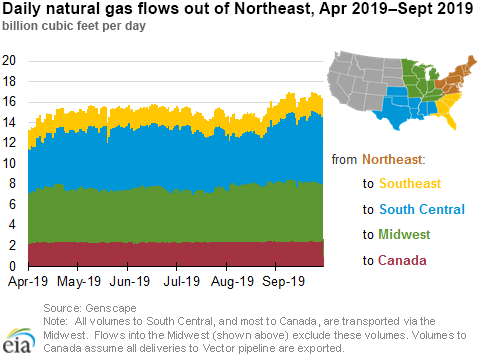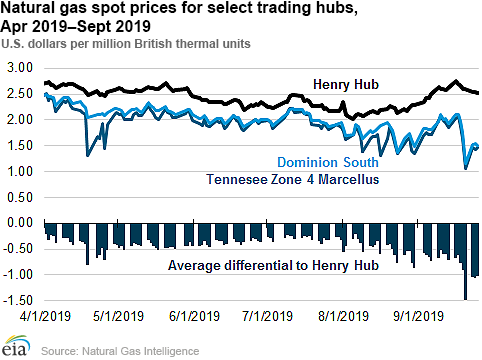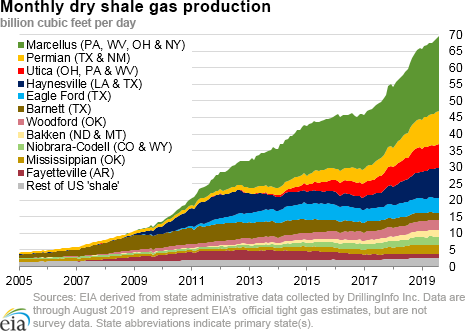In the News:
Low natural gas spot prices in Northeast drive additional flows out of the region
Natural gas flows out of the Northeast region have averaged more than 16 billion cubic feet per day (Bcf/d) during September—between 1 Bcf/d and 2 Bcf/d higher than in previous months, according to data from Genscape. This has occurred as Northeast natural gas spot prices in the Appalachian producing areas have declined.
During the report week (September 18‒25), natural gas prices at Appalachian supply hubs, Dominion South and Tennessee Zone 4 Marcellus, have fallen from both being about $2 per million British thermal units (MMBtu) on September 18 to $1.51/MMBtu and $1.46/MMBtu, respectively, on September 25. These lower prices have resulted in more favorable economics for transporting natural gas volumes from the Northeast to other regional demand markets—notably those in the South Central (i.e., the Gulf Coast) and Midwest regions.
Natural gas spot prices at Dominion South, located in southwestern Pennsylvania, and Tennessee Zone 4 Marcellus, located in northeastern Pennsylvania, typically averaged 20¢/MMBtu–50¢/MMBtu lower than Henry Hub prices this spring and summer, with this discount widening in August. So far in September, the average natural gas spot prices at these hubs has been $0.78/MMBtu lower than Henry Hub spot prices, with the difference to Henry Hub widening to an average of $1.04/MMBtu lower during the past week (September 18‒25). Similarly, the differential between Appalachian Basin natural gas spot prices and those at the Chicago Citygate has also widened from 20¢/MMBtu earlier in 2019 to 57¢/MMBtu on average during the report week.
Flows from the Northeast directly into Midwest demand markets have grown from 5.1 Bcf/d to 5.7 Bcf/d, primarily because of increased utilization on the Rover and Rockies Express pipelines. The additional flows on these pipelines coincided with an explosion on the Texas Eastern Transmission (TETCO) pipeline (1.7 Bcf/d capacity) on August 1, which forced re-routing of southbound TETCO flows of natural gas out of the Northeast onto other pipelines. However, volumes delivered to the Midwest have continued to rise despite TETCO returning to partial service in late August.
The explosion on the TETCO system limited southbound capacity out of the Northeast; however, flows from the Northeast via the Midwest to the South Central demand markets have increased, growing from an average of 5.6 Bcf/d from April through July to 6.3 Bcf/d so far in September 2019. Southbound flows on the Tennessee Gas Pipeline (TGP) and Columbia Gulf Pipeline increased by 0.6 Bcf/d and 0.5 Bcf/d, respectively, and account for most of the increase. These pipelines have been flowing at or near full capacity for most of September, according to Genscape.
Overview:
(For the week ending Wednesday, September 25, 2019)
- Natural gas spot prices fell at most locations this report week (Wednesday, September 18 to Wednesday, September 25). Henry Hub spot prices fell from $2.68/MMBtu last Wednesday to $2.51/MMBtu yesterday.
- At the New York Mercantile Exchange (Nymex), the price of the October 2019 contract decreased 14¢ from $2.637/MMBtu last Wednesday to $2.502/MMBtu yesterday. The price of the 12-month strip averaging October 2019 through September 2020 futures contracts declined 8¢/MMBtu to $2.505/MMBtu.
- Net injections to working gas totaled 102 Bcf for the week ending September 20. Working natural gas stocks are 3,205 Bcf, which is 16% more than the year-ago level and 1% lower than the five-year (2014–18) average for this week.
- The natural gas plant liquids composite price at Mont Belvieu, Texas, rose by 6¢/MMBtu, averaging $5.05/MMBtu for the week ending September 25. The price of ethane fell by 9%. The price of natural gasoline, propane, butane, and isobutane rose by 1%, 1%, 2%, and 21%, respectively. Isobutane’s premium to butane is the highest since June 2018.
- According to Baker Hughes, for the week ending Tuesday, September 17, the natural gas rig count decreased by 5 to 148. The number of oil-directed rigs fell by 14 to 719. The total rig count decreased by 18, and it now stands at 868.
Prices/Supply/Demand:
Prices fall at most locations amid mild temperatures. This report week (Wednesday, September 18 to Wednesday, September 25), Henry Hub spot prices fell 17¢ from $2.68/MMBtu last Wednesday to a low of $2.51/MMBtu yesterday. Temperatures were cooler than normal west of the Rockies and warmer than normal in the east, especially across the Great Plains. At the Chicago Citygate, prices decreased 38¢ from a high of $2.39/MMBtu last Wednesday to $2.01/MMBtu yesterday, with temperatures averaging at about 70 degrees Fahrenheit (°F).
California prices are mixed. Prices at PG&E Citygate in Northern California fell 9¢, down from $3.11/MMBtu last Wednesday to $3.02/MMBtu yesterday. Prices at SoCal Citygate increased 54¢ from $3.18/MMBtu last Wednesday to $3.72/MMBtu yesterday. Average daily California temperatures ranged from 65°F to 75°F; however, Southern California experienced warmer-than-normal temperatures during the report week, leading to increased natural gas demand for power burn and lower net injections into storage.
Northeast prices fall. At the Algonquin Citygate, which serves Boston-area consumers, prices went down 34¢ from $2.14/MMBtu last Wednesday to a low of $1.80/MMBtu yesterday. At the Transcontinental Pipeline Zone 6 trading point for New York City, prices decreased 39¢ from $2.01/MMBtu last Wednesday to $1.62/MMBtu yesterday, reaching a low of $1.26/MMBtu on Friday.
Tennessee Zone 4 Marcellus spot prices decreased 41¢ from $1.87/MMBtu last Wednesday to $1.46/MMBtu yesterday, reaching a low of $1.06/MMBtu on Friday. Prices at Dominion South in southwest Pennsylvania fell 47¢ from $1.98/MMBtu last Wednesday to $1.51/MMBtu yesterday. See the In the News section for more analysis on Northeast prices.
Permian Basin discount to the Henry Hub narrows in September as the Gulf Coast Express pipeline enters service. Prices at the Waha Hub in West Texas, which is located near Permian Basin production activities, averaged $1.89/MMBtu last Wednesday, 79¢/MMBtu lower than Henry Hub prices. Yesterday, prices at the Waha Hub averaged $1.60/MMBtu, 91¢/MMBtu lower than Henry Hub prices. On average, September prices at Waha have doubled since last month, narrowing the discount to the Henry Hub. Waha prices from September 1 through September 25 averaged $1.51/MMBtu, compared with an average of 70¢/MMBtu for the same days in August.
Kinder Morgan announced that its 2 Bcf/d Gulf Coast Express pipeline entered service on Wednesday. The pipeline will help alleviate takeaway constraints by transporting natural gas from the Permian Basin to demand centers on the Texas Gulf Coast.
Supply rises slightly. According to data from IHS Markit, the average total supply of natural gas rose by 1% compared with the previous report week. Dry natural gas production grew by 1% compared with the previous report week. Average net imports from Canada decreased by 6% from last week.
Demand declines, driven by the power sector. Total U.S. consumption of natural gas fell by 3% compared with the previous report week, according to data from IHS Markit. Natural gas consumed for power generation declined by 6% week over week. Industrial sector consumption stayed constant, averaging 21.1 Bcf/d. In the residential and commercial sectors, consumption increased by 7%. Natural gas exports to Mexico increased 6%.
U.S. liquefied natural gas (LNG) exports increase week over week. Twelve LNG vessels (seven from Sabine Pass, one from Cove Point, three from Corpus Christi, and one from Cameron LNG export terminals) with a combined LNG-carrying capacity of 44 Bcf departed the United States from September 19 through September 25, according to shipping data compiled by Bloomberg. Two vessels (one at Sabine Pass and one at Cameron LNG terminals) were loading on Wednesday.
Storage:
Net injections into storage totaled 102 Bcf for the week ending September 20, compared with the five-year (2014–18) average net injections of 74 Bcf and last year's net injections of 51 Bcf during the same week. Working gas stocks totaled 3,205 Bcf, which is 47 Bcf lower than the five-year average and 444 Bcf more than last year at this time.
According to The Desk survey of natural gas analysts, estimates of the weekly net change from working natural gas stocks ranged from net injections of 83 Bcf to 100 Bcf, with a median estimate of 91 Bcf.
The average rate of net injections into storage is 28% higher than the five-year average so far in the refill season (April through October). If the rate of injections into storage matched the five-year average of 10.7 Bcf/d for the remainder of the refill season, total inventories would be 3,645 Bcf on October 31, which is 47 Bcf lower than the five-year average of 3,692 Bcf for that time of year.
More storage data and analysis can be found on the Natural Gas Storage Dashboard and the Weekly Natural Gas Storage Report.
See also:
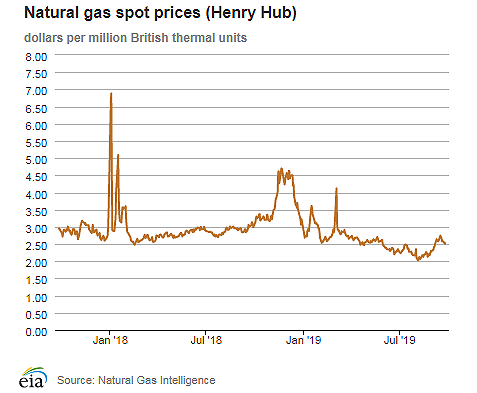
| Spot Prices ($/MMBtu) | Thu, 19-Sep |
Fri, 20-Sep |
Mon, 23-Sep |
Tue, 24-Sep |
Wed, 25-Sep |
|---|---|---|---|---|---|
| Henry Hub |
2.59 |
2.60 |
2.54 |
2.55 |
2.51 |
| New York |
1.72 |
1.26 |
1.62 |
1.65 |
1.62 |
| Chicago |
2.24 |
1.99 |
1.97 |
2.02 |
2.01 |
| Cal. Comp. Avg.* |
2.59 |
2.44 |
2.88 |
2.90 |
2.79 |
| Futures ($/MMBtu) | |||||
| October contract | 2.538 |
2.534 |
2.527 |
2.503 |
2.502 |
| November contract |
2.569 |
2.555 |
2.555 |
2.525 |
2.518 |
| *Avg. of NGI's reported prices for: Malin, PG&E Citygate, and Southern California Border Avg. | |||||
| Sources: Natural Gas Intelligence and CME Group as compiled by Bloomberg, L.P. | |||||
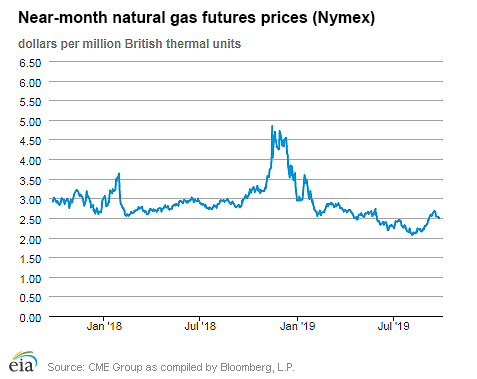
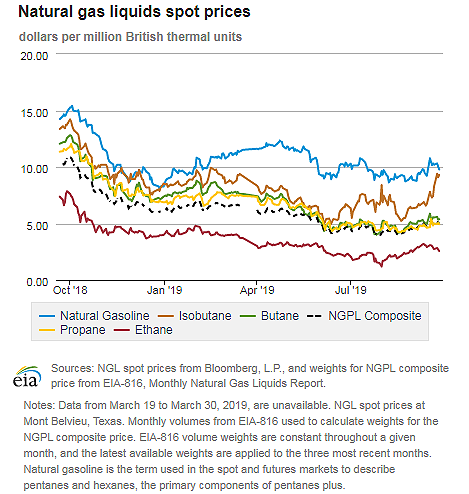
| U.S. natural gas supply - Gas Week: (9/19/19 - 9/25/19) | |||
|---|---|---|---|
Average daily values (Bcf/d): |
|||
this week |
last week |
last year |
|
| Marketed production | 105.1 |
104.1 |
97.0 |
| Dry production | 93.1 |
92.2 |
86.8 |
| Net Canada imports | 4.3 |
4.6 |
4.8 |
| LNG pipeline deliveries | 0.1 |
0.1 |
0.1 |
| Total supply | 97.5 |
96.9 |
91.7 |
|
Source: IHS Markit | |||
| U.S. natural gas consumption - Gas Week: (9/19/19 - 9/25/19) | |||
|---|---|---|---|
Average daily values (Bcf/d): |
|||
this week |
last week |
last year |
|
| U.S. consumption | 63.6 |
65.3 |
67.0 |
| Power | 33.2 |
35.4 |
36.6 |
| Industrial | 21.1 |
21.2 |
21.3 |
| Residential/commercial | 9.3 |
8.7 |
9.0 |
| Mexico exports | 5.3 |
5.0 |
5.0 |
| Pipeline fuel use/losses | 6.3 |
6.3 |
6.1 |
| LNG pipeline receipts | 6.1 |
6.5 |
2.9 |
| Total demand | 81.3 |
83.1 |
81.1 |
|
Source: IHS Markit | |||
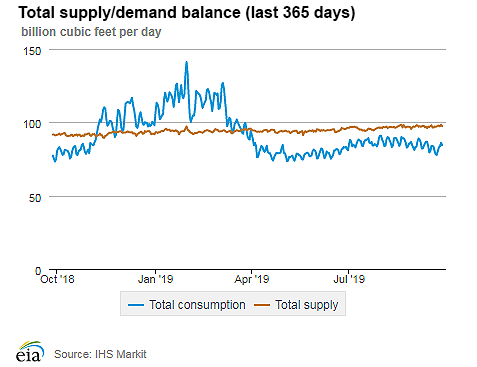
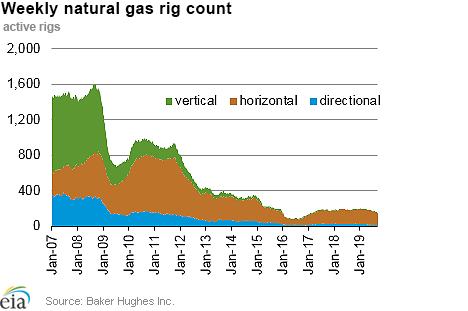
| Rigs | |||
|---|---|---|---|
Tue, September 17, 2019 |
Change from |
||
last week |
last year |
||
| Oil rigs | 719 |
-1.9% |
-17.0% |
| Natural gas rigs | 148 |
-3.3% |
-20.4% |
| Note: Excludes any miscellaneous rigs | |||
| Rig numbers by type | |||
|---|---|---|---|
Tue, September 17, 2019 |
Change from |
||
last week |
last year |
||
| Vertical | 51 |
-3.8% |
-21.5% |
| Horizontal | 756 |
-2.6% |
-17.7% |
| Directional | 61 |
7.0% |
-11.6% |
| Source: Baker Hughes Inc. | |||
| Working gas in underground storage | ||||
|---|---|---|---|---|
Stocks billion cubic feet (Bcf) |
||||
| Region | 2019-09-20 |
2019-09-13 |
change |
|
| East | 794 |
763 |
31 |
|
| Midwest | 934 |
898 |
36 |
|
| Mountain | 194 |
188 |
6 |
|
| Pacific | 286 |
279 |
7 |
|
| South Central | 998 |
974 |
24 |
|
| Total | 3,205 |
3,103 |
102 |
|
|
Source: Form EIA-912, Weekly Underground Natural Gas Storage Report | ||||
| Working gas in underground storage | |||||
|---|---|---|---|---|---|
Historical comparisons |
|||||
Year ago (9/20/18) |
5-year average (2014-2018) |
||||
| Region | Stocks (Bcf) |
% change |
Stocks (Bcf) |
% change |
|
| East | 726 |
9.4 |
803 |
-1.1 |
|
| Midwest | 796 |
17.3 |
913 |
2.3 |
|
| Mountain | 173 |
12.1 |
198 |
-2.0 |
|
| Pacific | 258 |
10.9 |
309 |
-7.4 |
|
| South Central | 809 |
23.4 |
1,030 |
-3.1 |
|
| Total | 2,761 |
16.1 |
3,252 |
-1.4 |
|
| Source: Form EIA-912, Weekly Underground Natural Gas Storage Report | |||||
| Temperature – heating & cooling degree days (week ending Sep 19) | ||||||||
|---|---|---|---|---|---|---|---|---|
HDD deviation from: |
CDD deviation from: |
|||||||
| Region | HDD Current |
normal |
last year |
CDD Current |
normal |
last year |
||
| New England | 44 |
14 |
42 |
2 |
-1 |
-30 |
||
| Middle Atlantic | 15 |
-7 |
15 |
11 |
-1 |
-36 |
||
| E N Central | 3 |
-23 |
2 |
37 |
24 |
-17 |
||
| W N Central | 6 |
-25 |
1 |
61 |
43 |
-4 |
||
| South Atlantic | 1 |
-5 |
1 |
85 |
25 |
-12 |
||
| E S Central | 0 |
-6 |
0 |
102 |
54 |
3 |
||
| W S Central | 0 |
-2 |
0 |
117 |
37 |
9 |
||
| Mountain | 12 |
-24 |
5 |
48 |
10 |
-11 |
||
| Pacific | 6 |
-5 |
-2 |
33 |
3 |
12 |
||
| United States | 7 |
-12 |
4 |
55 |
20 |
-9 |
||
|
Note: HDD = heating degree day; CDD = cooling degree day Source: National Oceanic and Atmospheric Administration | ||||||||
Average temperature (°F)
7-day mean ending Sep 19, 2019
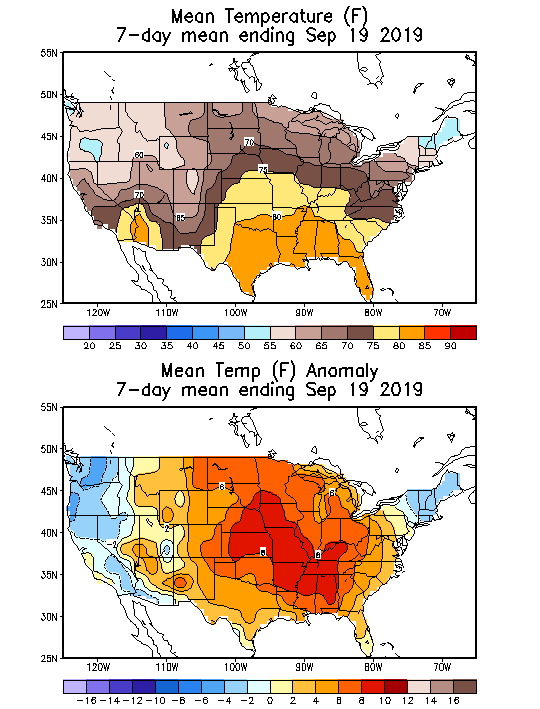
Source: National Oceanic and Atmospheric Administration
Deviation between average and normal (°F)
7-day mean ending Sep 19, 2019

Source: National Oceanic and Atmospheric Administration

